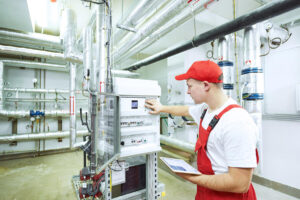HVAC is still one of the biggest energy consumers and that will never change. That is why the goal has to lessen the consumption of energy while not compromising the quality. Technology has actively played a major role in the changes. Construction management software was already introduced and deployed in the industry and as expected it made project management much better. For the HVAC industry, there are a lot of expectations for all the latest developments and trends. The great thing is, these trends are gearing towards the goal of lowering the amount of energy being used either when heating or cooling facilities. But most importantly, the process is environmentally-friendly. HVAC technicians, the experts, and other engineers have been ultimately passionate in looking for new strategies in order to improve the HVAC landscape.
Basically, most answers have relied in enhanced and more developed technologies as well as renewable energy resources or perhaps even a comprehensive re-imagining of how HVAC systems really work.
Below is a list of latest HVAC trends that are taking over in the industry this year of 2020:
- Sustainable HVAC system
The majority of the constructed buildings are usually designed with sustainability. This movement is new and has been closely referred to as Green construction, or sustainable building design. It is believed that the HVAC system in these buildings is considered as a major component in terms of sustainable building design. The primary reason is that the cooling and heating system are the key sources of building energy consumption. The concept of sustainable design has greatly caused engineers and architects to rethink designs for ventilation systems. They tend to use more natural airflow in order to reduce energy costs. Other options have pushed them to be selective in terms of building materials. They prefer the building to be kept at a more consistent temperature, completely reducing the requirement for high-powered HVAC.
When the construction begins, all participating technicians and the crew collaborate with one another. For project managers, they tend to use project management software in order to efficiently manage and monitor the overall phases of the project and also the crew. Tracking and monitoring all tasks and hours of labor is manageable. This software tool has a continuous significance years after years and sooner or later the same way for the new HVAC trends.
- Solar HVAC system
A solar HVAC system can widely be installed in retrofitted construction to existing buildings. This type of system typically uses solar paneling in order to fully absorb both light and heat energy (thermal energy) direct from the sun. When it comes to heating applications, the thermal energy is usually used in order to directly heat a fluid. The fluid is typically a mixture of antifreeze and water at the same time. This mixture will run through the heat exchanger. The process itself tends to create the heated air and this will eventually warm the facilities and buildings.
Assuming that the building already has an existing AC system, refitting it to be solar powered is possible. Solar power is generally used in generating electricity that is necessary for running the system. The system employs a cooling method where in the air is typically cooled due to the evaporation from the contained water.
The following are the benefits of solar thermal cooling:
- Adaptability for the latest installs and retrofits
- Scalability – no system is too small or too huge
- IRR or Internal Rates of Return of 20-70% on investments
- Reduction of peak demand
- Reduction in entire HVAC/R energy consumption
- No more moving parts and also small footprints
- Geothermal Heating and Cooling
This one is known for its complexity. A geothermal HVAC system is consist of a system of pipes and the pipes are typically buried underground. The area is referred as the earth loop. During every change of seasons, ground temperatures remain consistent despite the rise and fall of ambient air. Geothermal heating as well as cooling systems have taken advantage in this consistency through either cooling or heating buildings and switching it.
Nothing can beat the proven benefits of this type of HVAC system:
- Positive Cash Flow
- Eco-Friendly Operation
- Quieter Operation
- Safety
- Life-Cycle cost
- Increased Comfortability
- Always Ready Supply of Hot Water
- Smart HVAC system
IoT or Internet of Things is widely growing and expanding in many ways, enabling any systems and new devices people often used the most for communication. IoT has already influenced the strategy of project management in construction jobs and projects through the application of construction scheduling software today. The same way in the HVAC industry as well.
The great thing also is, HVAC trends are starting to incorporate the innovative capabilities catered by IoT. Imagine that HVAC system will give you alerts when it desperately needs instant repair. Other than repair alerts, alerts for regular maintenance check that is done on a regular basis can also be possible. Scheduling the appointment is way beyond easier with this. Remote functionalities are available for overall control of building’s HVAC system. Moreover, newly added sensors only for the compressors and thermostat as well as other specific areas can efficiently help regulate how the system itself must run. All mentioned technologies have aimed to run and control the system more efficiently in order to save money.
Making an HVAC system “SMART”
Not all elements of the HVAC system can be turned or made as intelligent. However, the following changes and alterations can able to make the simple system smart and energy-efficient.
- Ventilation & Air Supply
The ventilation system is definitely the main focus of this. It directs air whenever and wherever it is needed in buildings. In newly constructed commercial facilities and buildings these days, ventilation systems that are complex are typically modelled previously with BIM technology. This doesn’t only apply to commercial buildings but also for residential construction purposes. Professional experts and engineers usually have to design the HVAC system making sure to provide for ventilation designs as well. Providing air to any occupied rooms and keeping the temperature at the most comfortable level is the overall goal.
- Thermostat
Smart thermostats usually measure the current temperature however it doesn’t measure only the temperature but also occupancy, humidity, and any other present variables. Using the thermostat and all of its features, one can have better decisions specifically in adjusting the room temperatures as well as the setbacks. Another way of turning a thermostat from a standard one to smart is by placing it in the right place.
- Compressor and Air Handler
The compressor that has been referred more as the electric pump usually compressed refrigerant as well as the air handler. The Air handler is responsible for blowing the air over either the cooling or heating coils. These components have taken the main energy load on the system itself. That is why, it is important to consider optimizing these components so it won’t all become an ultimate energy drain. Efficiency can be fully achieved both in the equipment alongside with the other two major components that run only when these are necessary.
- Energy Analysis Software
Since all new upgraded HVAC systems are already stated above, let’s go over to other software tools other than the always mentioned construction schedule software. A new software tool like the Energy Gauge has been used now by many HVAC technicians before implementing any installations. Its primary purpose is to help contractors in saving time and for customers to save money. This type of software program has helped any projects the cost-efficient and best energy systems in any given space.
Energy Gauge was developed by the Florida Solar Energy Center from University of Central Florida. Below is what the software program offers:
- Provides cost/benefit analysis for any existing systems
- Engineers and architects can look for the appropriate equipment for designs
- Projecting the building’s lifetime energy consumption
- Implementing of non-HVAC techniques like reflective roofing and more
- Sensor-Enhanced Vents
Definitely, this is one of the several latest HVAC technology trends that greatly improve the industry. This innovation is offered and produced by the company widely known as Ecovent. It gives homeowners the capability to digitally control the current climate in any occupied and used rooms. A mobile app is available and smart sensors are very responsive that it will automatically collect the climate data.
Ecovent is the outstanding climate control system conveniently used at every home. Moreover, this is a fully-integrated system that will give homeowners the reliable and manageable control of all rooms.
These are the three major component parts of Ecovent:
- Vents – automatic opening and closing in order to get the right equal amount if airflow in any room
- Sensors – 24/ 7 monitoring, thus checking of temperatures, pressure and humidity is continuous
- Smart Hub – coordinates the comfort, provides protection of the HVAC system
- Mobile App –preferred room set points can be saved and adjusting the settings is easy
Key Takeaways
The continuous rise of these new technologies and other trends together with Internet of Things (IoT), the future HVAC equipment and other components will be sufficiently capable to self-diagnose and directly send out the initial findings to the repair teams and even manufacturers. Picture this out, the men and women who monitor the HVAC system will not do the same way of monitoring and tracking in the future. Thus, they will get busier in taking care and monitoring of computerized equipment rather than closely focusing on mechanical components.
Technology has not only greatly changed and improved the ways HVAC systems work but it also has majorly changed the role of the involved technicians in maintaining the system.





